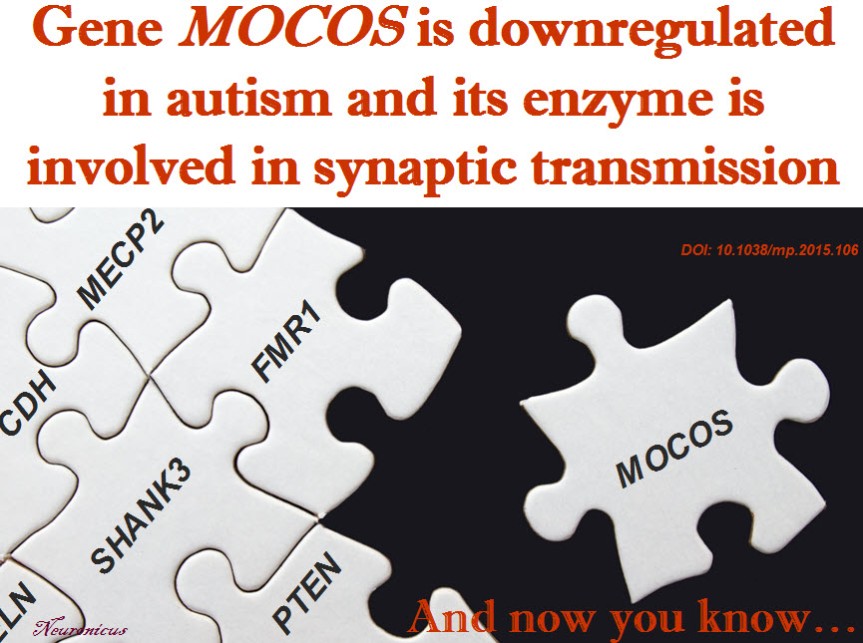Just like in the case of schizophrenia, hundreds of genes have been associated with autistic spectrum disorders (ASDs). Here is another candidate.

Féron et al. (2016) reasoned that most of the info we have about the genes that are behaving badly in ASDs comes from studies that used adult cells. Because ASDs are present before or very shortly after birth, they figured that looking for genetic abnormalities in cells that are at the very early stage of ontogenesis might prove to be enlightening. Those cells are stem cells. Of the pluripotent kind. FYI, based on what they can become (a.k.a how potent they are), the stem cells are divided into omipotent, pluripotent, multipotent, oligopotent, and unipotent. So the pluripotents are very ‘potent’ indeed, having the potential of producing a perfect person.
Tongue-twisters aside, the authors’ approach is sensible, albeit non-hypothesis driven. Which means they hadn’t had anything specific in mind when they had started looking for differences in gene expression between the olfactory nasal cells obtained from 11 adult ASDs sufferers and 11 age-matched normal controls. Luckily for them, as transcriptome studies have a tendency to be difficult to replicate, they found the anomalies in the expression of genes that have been already associated with ASD. But, they also found a new one, the MOCOS (MOlybdenum COfactor Sulfurase) gene, which was poorly expressed in ASDs (downregulated, in genetic speak). The enzyme is MOCOS (am I the only one who thinks that MOCOS isolated from nasal cells is too similar to mucus? is the acronym actually a backronym?).
The enzyme is not known to play any role in the nervous system. Therefore, the researchers looked to see where the gene is expressed. Its enzyme could be found all over the brain of both mouse and human. Also, in the intestine, kidneys, and liver. So not much help there.
Next, the authors deleted this gene in a worm, Caenorhabditis elegans, and they found out that the worm’s cells have issues in dealing with oxidative stress (e.g. the toxic effects of free radicals). In addition, their neurons had abnormal synaptic transmission due to problems with vesicular packaging.
Then they managed – with great difficulty – to produce human induced pluripotent cells (iPSCs) in a Petri dish in which the gene MOCOS was partially knocked down. ‘Partially’, because the ‘totally’ did not survive. Which tells us that MOCOS is necessary for survival of iPSCs. The mutant cells had less synaptic buttons than the normal cells, meaning they formed less synapses.
The study, besides identifying a new candidate for diagnosis and treatment, offers some potential explanations for some beguiling data that other studies have brought forth, like the fact that all sorts of neurotransmitter systems seem to be impaired in ADSs, all sorts of brain regions, making very hard to grab the tiger by the tail if the tiger is sprouting a new tail when you look at it, just like the Hydra’s heads. But, discovering a molecule that is involved in an ubiquitous process like synapse formation may provide a way to leave the tiger’s tail(s) alone and focus on the teeth. In the authors’ words:
“As a molecule involved in the formation of dense core vesicles and, further down, neurotransmitter secretion, MOCOS seems to act on the container rather than the content, on the vehicle rather than one of the transported components” (p. 1123).
The knowledge uncovered by this paper makes a very good piece of the ASDs puzzle. Maybe not a corner, but a good edge. Alright, even if it’s not an edge, at least it’s a crucial piece full of details, not one of those sky pieces.
Reference: Féron F, Gepner B, Lacassagne E, Stephan D, Mesnage B, Blanchard MP, Boulanger N, Tardif C, Devèze A, Rousseau S, Suzuki K, Izpisua Belmonte JC, Khrestchatisky M, Nivet E, & Erard-Garcia M (Sep 2016, Epub 4 Aug 2016). Olfactory stem cells reveal MOCOS as a new player in autism spectrum disorders. Molecular Psychiatry, 21(9):1215-1224. PMID: 26239292, DOI: 10.1038/mp.2015.106. ARTICLE | FREE FULLTEXT PDF
By Neuronicus, 31 August 2016


One thought on “Another puzzle piece in the autism mystery”
Comments are closed.